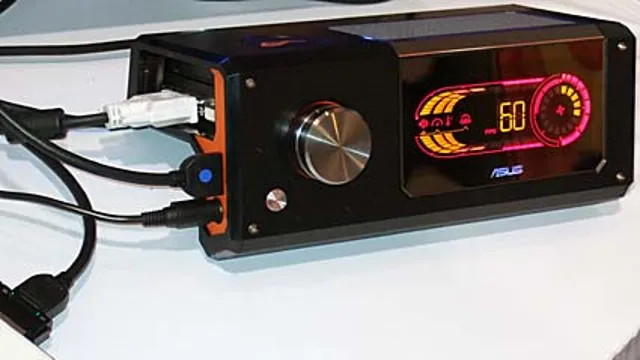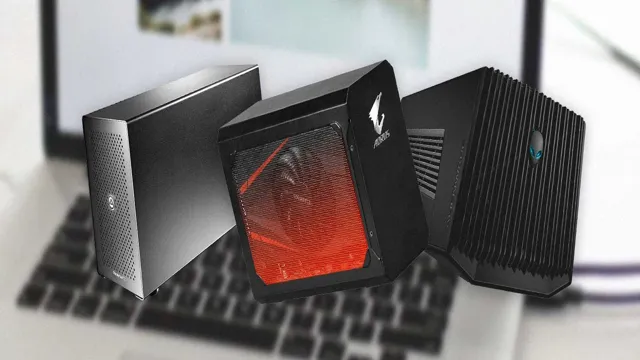Computers have become an essential part of our daily lives. With the increasing demand for better gaming graphics, many people are looking for ways to improve their PC’s performance. One of the best ways to do that is by getting an external graphics card for your PC.
External graphics cards, also known as eGPUs, provide a significant boost to your computer’s graphics capabilities. They are especially useful for laptops that have limited upgrade options. An external GPU is a compact and portable device that connects to your computer through a Thunderbolt or USB-C connector.
It contains a graphics card and dedicated memory, and it allows your computer to use the GPU’s processing power for gaming and other graphics-intensive applications. The external GPU can provide up to four times the graphics performance of an integrated graphics card, making it a worthwhile investment for gamers and graphic designers alike. If you’re new to the concept of external graphics cards, you might wonder how they work and if they’re worth the investment.
In this blog post, we’ll explore everything you need to know about eGPUs, including their benefits, compatibility, and how they compare to desktop graphics cards. By the end, you’ll have a better understanding of whether an external graphics card is right for you, and which one to consider. So, let’s dive in!
What is an External Graphics Card?
An external graphics card for a PC is a component that allows the user to enhance their computer’s graphical capabilities. It’s an upgrade that will usually be used by gamers, video editors, or anyone in need of high-quality graphics rendering. The external graphics card is separate from the computer’s internal graphics processor unit (GPU) and runs on its own power source.
This means that it can deliver better performance than the built-in GPU and consequently, elevate the user’s experience. Some external graphics cards are connected via Thunderbolt 3 for the best performance, while others rely on USB-C or PCIe connections. Overall, investing in an external graphics card for your PC is a wise move if you’re looking for a significant performance improvement in your computer’s graphics.
Definition and Functionality
An external graphics card, also known as an eGPU, is a type of device that aids in bolstering a computer’s visual performance. Simply put, it is a device that connects to a computer’s USB or Thunderbolt port to provide enhanced graphical abilities. This device is a popular option for laptop owners who want to improve their computer’s graphics capabilities, as it allows them to use high-end graphics cards that would otherwise be impossible to install due to size constraints.
It is also an ideal choice for those who want to upgrade their graphics card without buying a new computer. An eGPU is a fantastic tool for gamers or graphic designers who require high-quality graphics for their work. In essence, it allows a computer to perform more intensive visual tasks without strain, resulting in a smoother and more pleasing experience.

Why Do You Need an External Graphics Card for Your PC?
External graphics card If you are a gamer or someone who deals with graphics-intensive tasks like video editing, then an external graphics card can be a game-changer for your PC setup. An external graphics card, also known as eGPU, is an add-on device that plugs into your computer’s USB or Thunderbolt port to enhance its graphics processing capabilities. Even if you have a dedicated graphics card on your PC, an external graphics card can give you a significant boost in performance and quality.
With an external graphics card, you can run the latest games or applications that require high graphics requirements smoothly. Moreover, you can connect multiple displays to your PC, which can be useful for multitasking or creative work. In short, an external graphics card is a great way to improve your PC’s performance and get the most out of your setup.
Choosing the Best External Graphics Card
If you’re looking to boost your PC’s graphics capabilities, an external graphics card may be just what you need. An external graphics card, also known as an eGPU, is a device that connects to your computer and provides additional graphics processing power. When choosing the best external graphics card for your PC, there are a few things to consider.
First, make sure the card is compatible with your computer’s operating system and hardware. You’ll also want to consider the card’s performance and how much power it will consume. Other important factors include the card’s cooling capabilities, its connectivity options, and its overall reliability.
By taking these factors into account, you can find the best external graphics card for your needs and enjoy smoother, more visually appealing gaming and multimedia experiences. And with the right card, you’ll be able to handle even the most demanding applications with ease. So if you’re ready to take your PC to the next level, an external graphics card could be the perfect solution.
Compatibility with Your PC
When it comes to choosing the best external graphics card for your PC, it’s important to consider compatibility. Not all graphics cards are created equal, and not all will work with your specific set-up. That’s why it’s important to do your research and make sure the graphics card you choose is compatible with your PC’s hardware and software.
Whether you’re a gamer or a creative professional, a good graphics card can make all the difference in your performance. So, don’t overlook compatibility when making your selection. Look for a card that works seamlessly with your set-up and watch as your graphics performance reaches new heights.
Performance and Gaming Needs
For gamers and performance enthusiasts, an external graphics card (eGPU) can greatly enhance your computer’s graphics capabilities. Choosing the best eGPU for your needs can be a daunting task, but it’s important to consider factors such as compatibility, power supply, and graphics card compatibility. You’ll want to make sure that the eGPU you choose is compatible with your computer, and has enough power to support the graphics card you want to use.
It’s also important to consider the type of graphics card you want to use, whether it be Nvidia or AMD. Both offer great performance, but it’s important to research and find the best fit for your specific needs. Overall, an eGPU can be a great investment for those who need a boost in graphics performance for gaming or other demanding tasks.
Budget and Brand
When it comes to choosing the best external graphics card for your budget and brand, there are a few things to consider before making your final decision. One of the most important factors is your budget. External graphics cards can range drastically in price, from budget-friendly options to high-end models that come with a hefty price tag.
It’s important to determine how much you’re willing to spend before beginning your search. Another factor to consider is brand reputation. Some brands have a better reputation than others when it comes to reliability and performance, so it’s essential to read reviews and do your research before settling on a particular brand.
Ultimately, the best choice for you will depend on your specific needs and preferences. So, take the time to consider your budget and brand preferences before selecting an external graphics card to ensure you make the best decision possible.
Installing and Setting up Your External Graphics Card
Are you looking to upgrade your PC’s graphics performance without having to buy a whole new computer? One solution to consider is adding an external graphics card. Installing and setting up an external graphics card is a relatively straightforward process, but it does require a few steps. First, make sure your PC has a compatible port for the external graphics card, such as Thunderbolt
Then, ensure that your computer’s BIOS is updated to the latest version. Next, connect the external graphics card to your computer using the appropriate cable, and install any necessary drivers. Finally, configure your computer’s settings to utilize the external graphics card for optimal performance.
With a little patience and attention to detail, you can significantly boost your PC’s graphics capabilities with the addition of an external graphics card. So why not consider this cost-effective solution to give your computer a graphics boost?
Step-by-Step Guide
If you’re looking to upgrade your computer’s graphics processing prowess, an external graphics card might be just what you need. Setting up an external graphics card can provide significant boosts in performance, and it’s a relatively straightforward process. Firstly, you’ll need to purchase an external graphics card enclosure compatible with your computer’s operating system.
Afterward, install the graphics card into the enclosure and connect it to your computer via a compatible port such as Thunderbolt. Installing the correct drivers for the graphics card is crucial, and you’ll need to visit the manufacturer’s website to download the correct ones. Once you’ve installed the drivers, you’re ready to go! Your external graphics card will provide a significant performance boost for your games or other graphics-intensive applications.
So why not give it a try and see how much quicker and smoother your graphics become?
Troubleshooting Tips
If you’re experiencing issues setting up your external graphics card, there are a few troubleshooting tips you can try. First, make sure that your computer meets the minimum system requirements for the graphics card. If it does not, you may need to upgrade some components or consider a different graphics card.
Next, ensure that the graphics card is seated properly in the PCIe slot and that power cables are connected securely to it. If everything is connected correctly and your computer still isn’t recognizing the graphics card, try updating your BIOS or disabling the integrated graphics card. Additionally, check to see if there are any conflicts with other hardware or software on your system.
By following these tips, you should be able to get your external graphics card up and running smoothly.
Conclusion
In conclusion, adding an external graphics card to your PC is like giving it a superhero upgrade. Suddenly, your computer can handle even the most demanding games and applications with ease, soaring to new heights of power and efficiency. It’s like giving your trusty steed a jet pack – suddenly, you’re unstoppable.
So if you’re ready to take your PC to the next level, don’t hesitate – Upgrade with an external graphics card today!”
FAQs
What is an external graphics card for a PC?
An external graphics card, also known as an eGPU, is a device that enhances the graphical performance of a computer by connecting to it via a Thunderbolt or USB-C port. It allows for high-end graphics processing capabilities without the need for an upgraded internal graphics card.
Can any PC use an external graphics card?
Not all computers are capable of using an external graphics card. The computer must have a Thunderbolt or USB-C port that supports external graphics, and the computer’s BIOS settings must allow for the use of an external GPU.
What are the advantages of using an external graphics card?
External graphics cards can significantly improve the graphical performance of a PC, allowing for a better gaming or video editing experience. External graphics cards are also easily upgradable, making them a cost-effective solution for improving a computer’s graphics performance without having to replace the entire system.
Are there any drawbacks to using an external graphics card?
One of the main drawbacks of using an external graphics card is the cost. External GPUs can be expensive, especially if you want a high-end model. Additionally, not all computers are compatible, which could limit your options. Finally, using an external graphics card can also lead to a loss of mobility, as the device needs to be connected to the computer at all times.
